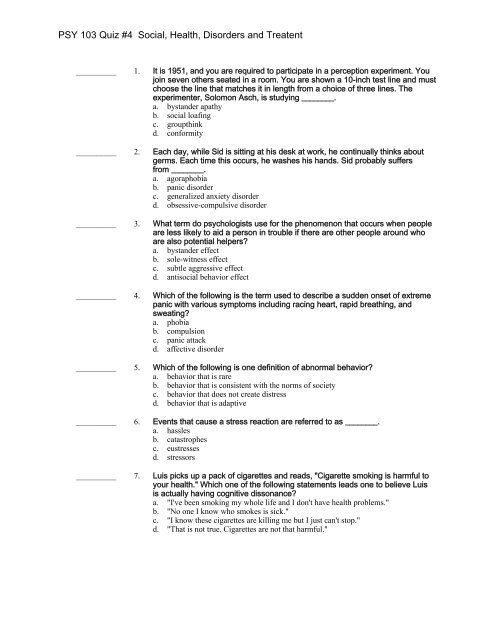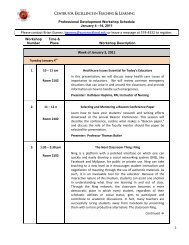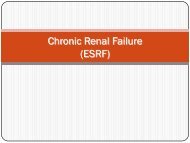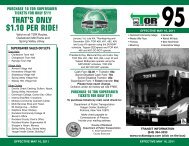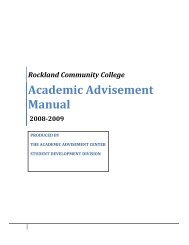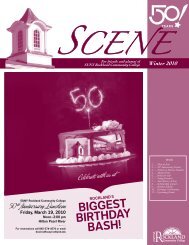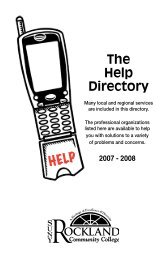PSY 103 Quiz #4 Social, Health, Disorders and Treatent - SUNY ...
PSY 103 Quiz #4 Social, Health, Disorders and Treatent - SUNY ...
PSY 103 Quiz #4 Social, Health, Disorders and Treatent - SUNY ...
Create successful ePaper yourself
Turn your PDF publications into a flip-book with our unique Google optimized e-Paper software.
<strong>PSY</strong> <strong>103</strong> <strong>Quiz</strong> <strong>#4</strong> <strong>Social</strong>, <strong>Health</strong>, <strong>Disorders</strong> <strong>and</strong> <strong>Treatent</strong><br />
__________ 1. It is 1951, <strong>and</strong> you are required to participate in a perception experiment. You<br />
join seven others seated in a room. You are shown a 10-inch test line <strong>and</strong> must<br />
choose the line that matches it in length from a choice of three lines. The<br />
experimenter, Solomon Asch, is studying ________.<br />
a. byst<strong>and</strong>er apathy<br />
b. social loafing<br />
c. groupthink<br />
d. conformity<br />
__________ 2. Each day, while Sid is sitting at his desk at work, he continually thinks about<br />
germs. Each time this occurs, he washes his h<strong>and</strong>s. Sid probably suffers<br />
from ________.<br />
a. agoraphobia<br />
b. panic disorder<br />
c. generalized anxiety disorder<br />
d. obsessive-compulsive disorder<br />
__________ 3. What term do psychologists use for the phenomenon that occurs when people<br />
are less likely to aid a person in trouble if there are other people around who<br />
are also potential helpers?<br />
a. byst<strong>and</strong>er effect<br />
b. sole-witness effect<br />
c. subtle aggressive effect<br />
d. antisocial behavior effect<br />
__________ 4. Which of the following is the term used to describe a sudden onset of extreme<br />
panic with various symptoms including racing heart, rapid breathing, <strong>and</strong><br />
sweating?<br />
a. phobia<br />
b. compulsion<br />
c. panic attack<br />
d. affective disorder<br />
__________ 5. Which of the following is one definition of abnormal behavior?<br />
a. behavior that is rare<br />
b. behavior that is consistent with the norms of society<br />
c. behavior that does not create distress<br />
d. behavior that is adaptive<br />
__________ 6. Events that cause a stress reaction are referred to as ________.<br />
a. hassles<br />
b. catastrophes<br />
c. eustresses<br />
d. stressors<br />
__________ 7. Luis picks up a pack of cigarettes <strong>and</strong> reads, "Cigarette smoking is harmful to<br />
your health." Which one of the following statements leads one to believe Luis<br />
is actually having cognitive dissonance?<br />
a. "I've been smoking my whole life <strong>and</strong> I don't have health problems."<br />
b. "No one I know who smokes is sick."<br />
c. "I know these cigarettes are killing me but I just can't stop."<br />
d. "That is not true. Cigarettes are not that harmful."
<strong>PSY</strong> <strong>103</strong> <strong>Quiz</strong> <strong>#4</strong> <strong>Social</strong>, <strong>Health</strong>, <strong>Disorders</strong> <strong>and</strong> <strong>Treatent</strong><br />
__________ 8. Excessive or unrealistic fearfulness <strong>and</strong> worry are characteristic of ________.<br />
a. mood disorders<br />
b. dissociative neurosis<br />
c. anxiety disorders<br />
d. amnesia<br />
__________ 9. Nick is admitted to a mental institution because he hears voices talking to him<br />
that no one else can hear, <strong>and</strong> he sees demons attacking him, though no one<br />
else could see anything near him. Nick's symptoms are known as ________.<br />
a. delusions<br />
b. hallucinations<br />
c. obsessions<br />
d. compulsions<br />
__________ 10. A person who is ambitious, time conscious, extremely hardworking, easily<br />
annoyed, <strong>and</strong> tends to have high levels of hostility <strong>and</strong> anger is said to be<br />
exhibiting a ________ personality.<br />
a. Type A<br />
b. Type S<br />
c. Type B<br />
d. Type C<br />
__________ 11. Imagine 100 individuals are asked to take part in a replication of Milgram's<br />
famous study on obedience. How are these 100 people likely to respond?<br />
a. The majority would administer 450 volts as instructed.<br />
b. The majority would immediately realize the use of deception <strong>and</strong> leave.<br />
c. Most of the women would refuse to obey, whereas almost all of the men would<br />
obey.<br />
d. Most of the participants would work together to force the experimenter to end the<br />
experiment.<br />
__________ 12. A person who suffers from bipolar disorder alternates between ________.<br />
a. anxiety <strong>and</strong> mania<br />
b. depression <strong>and</strong> manic episodes<br />
c. mania <strong>and</strong> schizophrenia<br />
d. depression <strong>and</strong> schizophrenia<br />
__________ 13. Dave believes all college professors are irritable, impatient, <strong>and</strong> uninterested in<br />
whether students learn. His belief is an example of ________.<br />
a. consensus<br />
b. impressions<br />
c. an attitude<br />
d. a stereotype<br />
__________ 14. What is the the primacy effect, as it relates to impression formation, more<br />
commonly known as?<br />
a. first impression<br />
b. negative attribution<br />
c. situational bias<br />
d. altruism<br />
__________ 15. Therapy that depends on identifying <strong>and</strong> changing distorted thinking <strong>and</strong><br />
unrealistic beliefs is ________ therapy.<br />
a. cognitive<br />
b. psychoanalytic<br />
c. behavior<br />
d. person-centered
<strong>PSY</strong> <strong>103</strong> <strong>Quiz</strong> <strong>#4</strong> <strong>Social</strong>, <strong>Health</strong>, <strong>Disorders</strong> <strong>and</strong> <strong>Treatent</strong><br />
__________ 16. Psychoanalysis was a therapy technique designed by __________.<br />
a. Fritz Perls<br />
b. Sigmund Freud<br />
c. Carl Rogers<br />
d. Alfred Adler<br />
__________ 17. In Zimbardo's prison study, male college students agreed to participate in a twoweek<br />
experiment to discover what would happen when they took on the roles<br />
of prisoners <strong>and</strong> guards. After the prisoners staged a revolt, the researchers<br />
found that ________.<br />
a. the guards became more aggressive<br />
b. all of the guards decided to quit the experiment<br />
c. the guards tried to be "tough but fair"<br />
d. the experimenters had everyone switch roles<br />
__________ 18. Major depression, dysthymia, <strong>and</strong> bipolar disorder are all examples of ________<br />
disorders.<br />
a. neurotic<br />
b. somatoform<br />
c. psychotic<br />
d. mood<br />
__________ 19. The primary purpose of the DSM-IV-TR is to ________.<br />
a. help psychologists assess only normal behavior<br />
b. keep the number of diagnostic categories of mental disorders to a minimum<br />
c. help psychological professionals diagnose psychological disorders<br />
d. describe the causes of common physiological disorders<br />
__________ 20. Manny has such an intense fear of flying insects that he hardly ever goes<br />
outside his house during the summer months. He is probably suffering from a<br />
________.<br />
a. somatoform disorder<br />
b. conversion reaction<br />
c. personality disorder<br />
d. phobic disorder
<strong>PSY</strong> <strong>103</strong> <strong>Quiz</strong> <strong>#4</strong> <strong>Social</strong>, <strong>Health</strong>, <strong>Disorders</strong> <strong>and</strong> <strong>Treatent</strong><br />
Test Name: <strong>Quiz</strong> <strong>#4</strong> <strong>Disorders</strong> <strong>and</strong> <strong>Social</strong><br />
1. d. conformity<br />
2. d. obsessive-compulsive disorder<br />
3. a. byst<strong>and</strong>er effect<br />
4. c. panic attack<br />
5. a. behavior that is rare<br />
6. d. stressors<br />
7. c. "I know these cigarettes are killing me but I just can't stop."<br />
8. c. anxiety disorders<br />
9. b. hallucinations<br />
10. a. Type A<br />
11. a. The majority would administer 450 volts as instructed.<br />
12. b. depression <strong>and</strong> manic episodes<br />
13. d. a stereotype<br />
14. a. first impression<br />
15. a. cognitive<br />
16. b. Sigmund Freud<br />
17. a. the guards became more aggressive<br />
18. d. mood<br />
19. c. help psychological professionals diagnose psychological disorders<br />
20. d. phobic disorder


